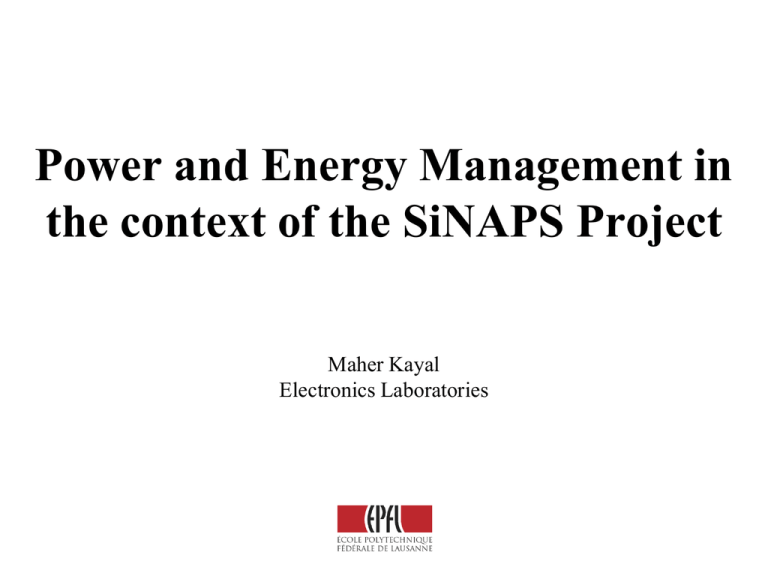Power and Energy Management in the context of the SiNAPS Project
advertisement

Power and Energy Management in the context of the SiNAPS Project Maher Kayal Electronics Laboratories Outline • Introduction: – SiNAPS Motes: Target Application – Sinaps Power Budget, pushing the limit • System-Level Overview: – Basic Concept, Charging Process • System-Level Design: – Challenges Overview: Energy Storage, Battery Charging • Sinaps Power Management Circuit: – Energy Management & Storage – Battery Management • Conclusion & Follow Up Zero Power Workshop 2/15 SiNAPS Motes: Target Application SiNAPS Mote Electronics: Power Management, Sensor Readout, Data Transmission SiNAPS Network Zero Power Workshop 3/15 Sinaps Power Budget, pushing the limit K. Baert et al, Microelectronics Journal 37, 1563 (2006) • New Energy Management Paradigm: • Reconfiguring system according to harvested energy • Targeting highest overall efficiency • Extremely low power block: • Sensor Interface: Sensor, CE-ADC • Power & energy Manager Demanded Specs: Design Considerations: Why Needed? • High efficiency Small Area • Appropriate Voltage Level • Intermittent Harvested Energy • Extremely low power • High Efficiency & Small Area • Intermittent Harvested Energy • Peak Power during RF TX/RX • Stable voltage for Electronics Zero Power Workshop 4/15 Sinaps, New Energy Management Paradigm K. Baert et al, Microelectronics Journal 37, 1563 (2006) Traditional Approach: • Assigned Power Budget: •Average power of energy harvester • Optimization Goal: • Meeting target Design Specifications with minimum power • Power Consumption: •Usually not reconfigurable Reconfigurable Approach: • Optimization Goal: • Reconfigurable specifications and power consumption according to available energy Zero Power Workshop 5/15 System-Level Design: Challenges Overview • Energy Storage Specifications: • Miniaturized Size • Nominal Voltage Level • High Discharge Current • Energy Capacity • Internal Resistance • Life Cycle Supercapacitors? Miniaturized Li-ION Batteries? Thin Film Li-ION Batteries? Miniaturized NiMH Batteries? • Power Management System: • Optimizing the overall efficiency • Targeting area requirements Switched Capacitor DC-DC Converter? Inductor-based DC-DC Converter? Direct Charging? Zero Power Workshop 6/15 System-Level Design: Energy Storage Option Energy Storage Option Advantages Disadvantages Miniaturized Supercaps High Output Power Very High Life Cycle Very Low Energy Capacity Fast Voltage Drop Very High Leakage Limited Output Power Thin Film Low leakage Current Li/ION Batteries High Cycle Life Big Area Very Low Output Power Low Capacity High Nominal Voltage Miniaturized Ni- Very High Output MH Batteries Power High Capacity Low Nominal Voltage Higher leakage Current Lower Life Cycle Zero Power Workshop 7/15 System-Level Design: Miniaturized Batteries Battery/ Specification Technology Seiko (MS412FE) Manganese Silicon Lithium 3V Seiko (TS518FE) Titanium Silicon Lithium 1.5V D: 4.8 mm H: 1.2 mm 1mAh (down to 2.0V) D: 5.8 mm H: 1.9 mm 1.5mAh (down to 1.0v) Internal Res (DC) D: 6.8mm H: 2.15mm 6.2mAh (@1.2mA, down to 1V) 9Ω 100Ω 120Ω Discharge Current 18mA 0.1mA 0.15mA Cycle Life 1000 1000 1000 Nominal Voltage Size Capacity Varta (MH 13654) NiMH 1.2V Zero Power Workshop 8/15 System-Level Design: Battery Charging Solution Solution Advantages Disadvantages Inductor-based DC-DC Converter High Potential Efficiency Voltage Up/Down Implementation MPPT1 Implementation (Potential High Accuracy) Big Area ( Inductor Normally External) High Power Consumption of PMC2 Switched Capacitor DCDC Converter Voltage Up/Down Implementation MPPT Implementation (Stepwise) Low Efficiency Big Area (Using Big Capacitors) High Power Consumption of PMC Direct Charging Potential High Efficiency Only Voltage Down Small Area Implementations Low Power Consumption of No MPPT Implementation PMC 1. MPPT: Max Power Point Tracking 2. PMC: Power Management Circuit Zero Power Workshop 9/15 System-Level Overview: Basic Concept ASIC Charge Control Voltage Tracking • High efficiency • Low-power analog implementation • Small silicon area ASIC Zero Power Workshop 10/15 System-Level Overview : Charging Process Vbat Vpvoc [1] Vpor [2] t POR RESET FREE t TEST t SWITCH t 1. Vpvoc= Open Circuit Voltage of PV Cell 2. Vpor= Power-On-Reset Voltage • The battery voltage is periodically compared to Vpvoc • The switch is opened to compare Vbat and Vpv Zero Power Workshop 11/15 Sinaps Power Management Circuit: Energy Management & Storage • Methodology: Direct Charging from PV cell to NiMH Battery • Advantage: High Efficiency, Simplicity, Low Power Consumption, No External Component Zero Power Workshop 12/15 Sinaps Power Management Circuit: Battery Management • Battery Voltage Level Detection: • Vthlow: POR (Power On Reset), Vthhigh: Enabling data transmission • Design Parameters: Battery Specification, Temperature Battery Volt. Capacity/ Size Iout Rout Main Disadvantages Varta V6HR (MH13654) 1.2V 18 mA 9Ω Loosing 20% in 1 month 1.72 µA 6.2mAh/ D: 6.8mm, H: 2.15mm Zero Power Workshop 13/17 13/15 Sinaps Power Budget: Sample Reconfigurable Approach Integrated Temperature Sensor with 12bits ADC • Methodology: Reconfigurable resolution & conversion rate according to available energy • Design Approach: Low Power, Small Area, Low Frequency, Switched-Capacitor based Circuits Zero Power Workshop 14/15 Conclusion & Follow Up • Fully Integrated Power Management System No External Component 0.7 mm 1 mm • Technology: UMC 0.18 • Power Consumption ≈ 300nW • Area (Power Management) ≈ 0.5 *0.5 mm2 • Implementation Details “Sinaps: Electronics Implementation of Power and Energy Management Scheme” by Naser Khosro Pour @ 11:40 Zero Power Workshop 15/15




